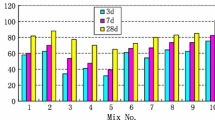Abstract
This paper presents preliminary results of a research project into the influence of moist curing on the potential durability of concrete. Durability is characterized by measuring the oxygen permeability and water absorption at various depths in the covercrete. Concretes containing plain OPC, an OPC-FA blend and an OPC-GGBS blend were used. A range of strength grades was tested for each of these binder types. Concretes were exposed to moist curing conditions for 1, 3, 7 and 28 days before being tested at 28 days after casting. The main conclusions are: (i) moist curing has a marked influence on the potential durability of concrete and (ii) a relatively greater influence on durability can be effected by extending the duration of early-age moist curing rather than decreasing the binder/water ratio.
Resume
On présente les résultats préliminaires d'un projet de recherche sur l'influence de la conservation en condition humide sur la durabilité potentielle du béton, qui se caractérise par la mesure de la perméabilité à l'oxygène et l'absorption d'eau à différentes profondeurs dans l'épaisseur d'enrobage du béton. On décrit aussi la mise au point d'un perméamètre économique à chute de pression contrôlée qu'on a utilisé pour mesurer la perméabilité à l'oxygène dans le béton.
On a utilisé pour les séries d'essai des bétons contenant du ciment Portland ordinaire (OPC), un mélange OPC-cendres volantes et OPC-laitier; chacun a été essayé sur un éventail de degrés de résistance. Les bétons ont été exposés à la conservation en condition humide pendant 1, 3, 7 et 28 jours avant d'être essayés à 28 jours après moulage.
On a ensuite découpé des disques de béton sur les éprouvettes cubiques, parallèlement à une face de moulage, correspondant à des profondeurs de 0–15, 15–30 et 30–45 mm. On a essayé la perméabilité à l'oxygène et la capacité de sorption d'eau de ces disques, qui marquent le développement de la microstructure de la phase du ciment, et par conséquent la durabilité.
En conclusion, (i) la conservation en condition humide a une influence certaine sur la durabilité potentielle; (ii) cette influence peut être relativement accrue plutôt en allongeant la durée de conservation en condition humide aux jeunes âges qu'en diminuant le rapport eau/liant; (iii) sur les trois types de liants essayés, les résultats les plus faibles de perméabilité à l'oxygène et de capacité de sorption d'eau ont été obtenus avec les bétons OPC-cendres volantes et les valeurs les plus élevées avec les bétons OPC-laitier.
Similar content being viewed by others
References
‘Curing Concrete Pavements’, Current Road Problems No. 1-R, Revised Edn (Highway Research Board, Washington, 1952).
Gowripalan, N., Cabrera, J. G., Cusens, A. R. and Wainwright, P. J., ‘Effect of curing on durability.’ACI Concr. Internatl: Desgn Constn (February 1990) 47–54.
Bentur, C. and Jaegerman, C., ‘Effect of curing and composition on the properties of the outer skin of concrete’,ASCE J. Mater. Civil Engng 3(4) (1991) 252–262.
Moskvin, V. (ed.), ‘Concrete and Reinforced Concrete Deterioration and Protection’ (Mir, Moscow, 1980).
‘Permeability Testing of Site Concrete’, Technical Report No. 31. (Concrete Society, London, 1987).
Schonlin, K. and Hilsdorf, H. K., ‘Permeability as a Measure of Potential Durability of Concrete-Development of a Suitable Test Apparatus’, in ACI SP-108, ‘Permeability of Concrete’ (American Concrete Institute, Detroit, 1988).
Dhir, R. K., Hewlett, P. C. and Chan, Y. N., ‘Near surface characteristics of concrete: intrinsic permeability’,Mag. Concr. Res. 41(147) (1989) 87–97.
Addis, B. J. (ed.), ‘Fulton's Concrete Technology’, 6th Edn (Portland Cement Institute, Midrand, 1986).
Ballim, Y., ‘A low cost, falling head permeameter for measuring concrete gas permeability’,Concrete/Beton, J. Concr. Soc. Southern Africa 61 (November 1991) 13–18.
Blight, G. E., ‘A falling head permeameter for testing asphalt’,Trans. South African Inst. Civil Engrs (June 1977) 123–126.
Cabrera, J. G. and Lynsdale, C. J., ‘A new gas permeameter for measuring the permeability of mortar and concrete’,Mag. Concr. Res. 40(144) (1988) 177–182.
Kelham, S., ‘A water absorption test for concrete’, ibid.Mag. Concr. Res. 40(143) (1988) 106–110.
Hall, C., ‘Water sorptivity of mortars and concretes: a review ibid.Mag. Concr. Res. 41(147) (1989) 51–61.
Author information
Authors and Affiliations
Rights and permissions
About this article
Cite this article
Ballim, Y. Curing and the durability of OPC, fly ash and blast-furnace slag concretes. Materials and Structures 26, 238–244 (1993). https://doi.org/10.1007/BF02472617
Issue Date:
DOI: https://doi.org/10.1007/BF02472617




